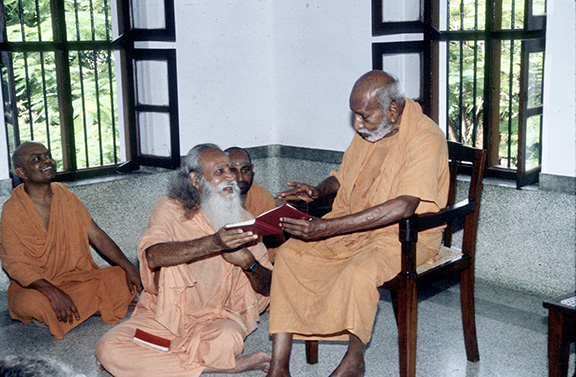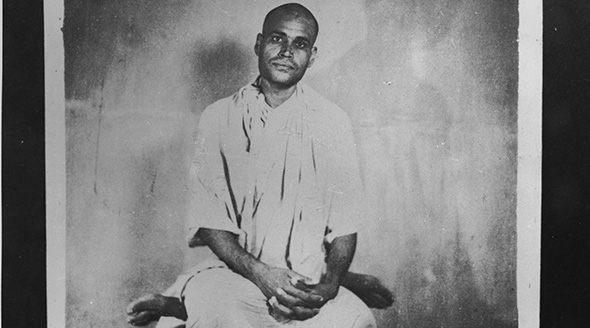
Visiting Swami Chidbhavanandaji, mid-1980s.
Ramu entered the Ramakrishna Mission at Thirupparaiturai, which was headed by Sri Swami Chidbhavanandaji Maharaj. Chidbhavanandaji was a disciple of Sri Swami Shivananda, one of the twelve apostles of the famous sage Sri Ramakrishna Paramahamsa.
Sri Ramakrishna was born in Bengal in 1836 and displayed a deep religious fervor even in childhood. The God-intoxicated state that consumed him revealed to his disciples the approachability of God through sincere prayer and supplication. His example of a spiritual life profoundly influenced India and produced many other great yogis such as Sri Swami Vivekananda. Sri Ramakrishna’s wife, Srimati Sharada Devi, was a very humble and holy woman; after Sri Ramakrishna passed away in 1886 his disciples asked that she continue as their guiding light. Sri Ramakrishna is still revered as a great God-realized being.
Chidbhavanandaji managed to live his secluded life in Thirupparaiturai for several years, but his nature was to serve. Slowly devotees started coming to him for guidance; he began to advise them, and a small ashram developed. In its early stages, only four disciples lived at this Thapovanam. One of these was Ramu.
It was time for Ramu to plunge even deeper into his spiritual commitment, and he decided to ask for brahmacharya diksha. This important initiation is the step into pre-monastic life, sometimes referred to as pre-sannyas. Ramakrishna Order monk Sri Swami Vipulanandaji, originally from Sri Lanka, performed the rites. On the day of the ceremony Ramu and his fellow initiates bathed in the river and received the pure, white garments a renunciate wears until he or she becomes an initiated monk. They were taught the Gayatri mantra and were presented with the sacred thread. From that day until his sannyas initiation he was known as Sambasiva Chaitanya. Chaitanya means absolute consciousness. It is included in the names of all pre-sannyasis. Sambasivam was the individual part of Ramu’s new name. It represents the true harmonizing of the individual soul with the Divine. Amba is the name of the goddess Shakti, the cosmic energy. Siva is a name of the cosmic consciousness. The goal of spiritual practice is to experience the union of these divine energies. Included in the initiation’s purifying ritual is the shaving of the head and face (see black & white photo), leaving only a small tuft of hair on the top of the initiate’s scalp. Sambasivam’s hair and beard had grown since his days at Chettipalayam. As soon as he shaved, a sudden change struck his system. The hair had served as a shield to neutralize the dense heat of the area. When it was removed, Sambasivam came down with a severe fever that lasted for a number of days. Sri Swami Chidbhavanandaji realized the problem and told the brahmachari to grow his hair once again, even though it was not the usual custom.

Recent Comments